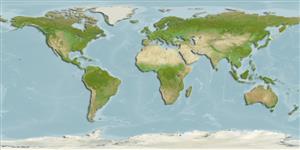Classification / Names
Noms communs | Synonymes | Catalog of Fishes(Genre, Espèce) | ITIS | CoL | WoRMS | Cloffa
Environment: milieu / climate zone / depth range / distribution range
Écologie
marin démersal; profondeur 20 - 30 m (Ref. 58496). Temperate
Northwest Pacific: southern Sea of Okhotsk to Japan Sea at Peter the Great Bay, and Pacific coast of southern Kuril Islands.
Taille / Poids / Âge
Maturity: Lm ? range ? - ? cm
Minimum depth reported at 20 m (Ref. 48811).
Life cycle and mating behavior
Maturité | Reproduction | Frai | Œufs | Fécondité | Larves
Mecklenburg, C.W. and B.A. Sheiko, 2003. Family Cyclopteridae Bonaparte 1831 - lumpsuckers. Calif. Acad. Sci. Annotated Checklists of Fishes (6):17. (Ref. 48811)
Statut dans la liste rouge de l'IUCN (Ref. 130435: Version 2024-1)
Menace pour l'homme
Harmless
Utilisations par l'homme
Outils
Articles particuliers
Télécharger en XML
Sources Internet
Estimates based on models
Phylogenetic diversity index (Ref.
82804): PD
50 = 0.5000 [Uniqueness, from 0.5 = low to 2.0 = high].
Bayesian length-weight: a=0.02089 (0.00774 - 0.05639), b=3.03 (2.80 - 3.26), in cm total length, based on LWR estimates for this (Sub)family-body shape (Ref.
93245).
Niveau trophique (Ref.
69278): 3.2 ±0.4 se; based on size and trophs of closest relatives
Résilience (Ref.
120179): Haut, temps minimum de doublement de population inférieur à 15 mois (Preliminary K or Fecundity.).
Fishing Vulnerability (Ref.
59153): Low vulnerability (10 of 100).
